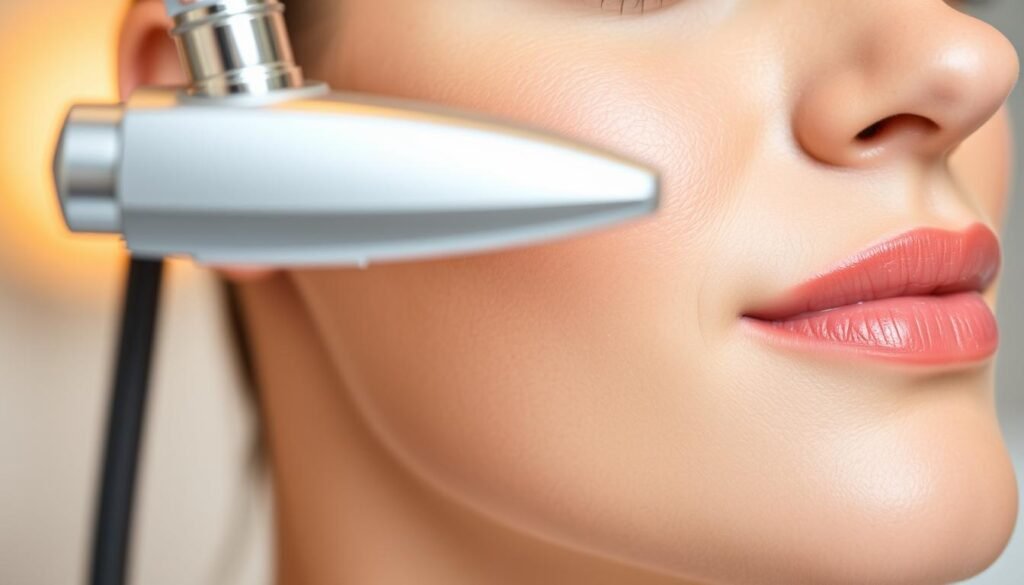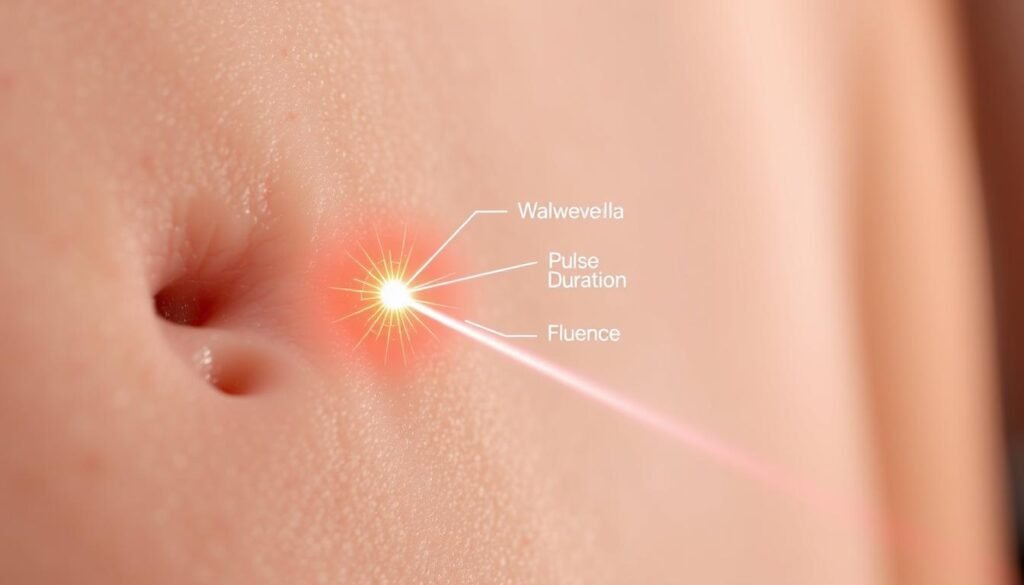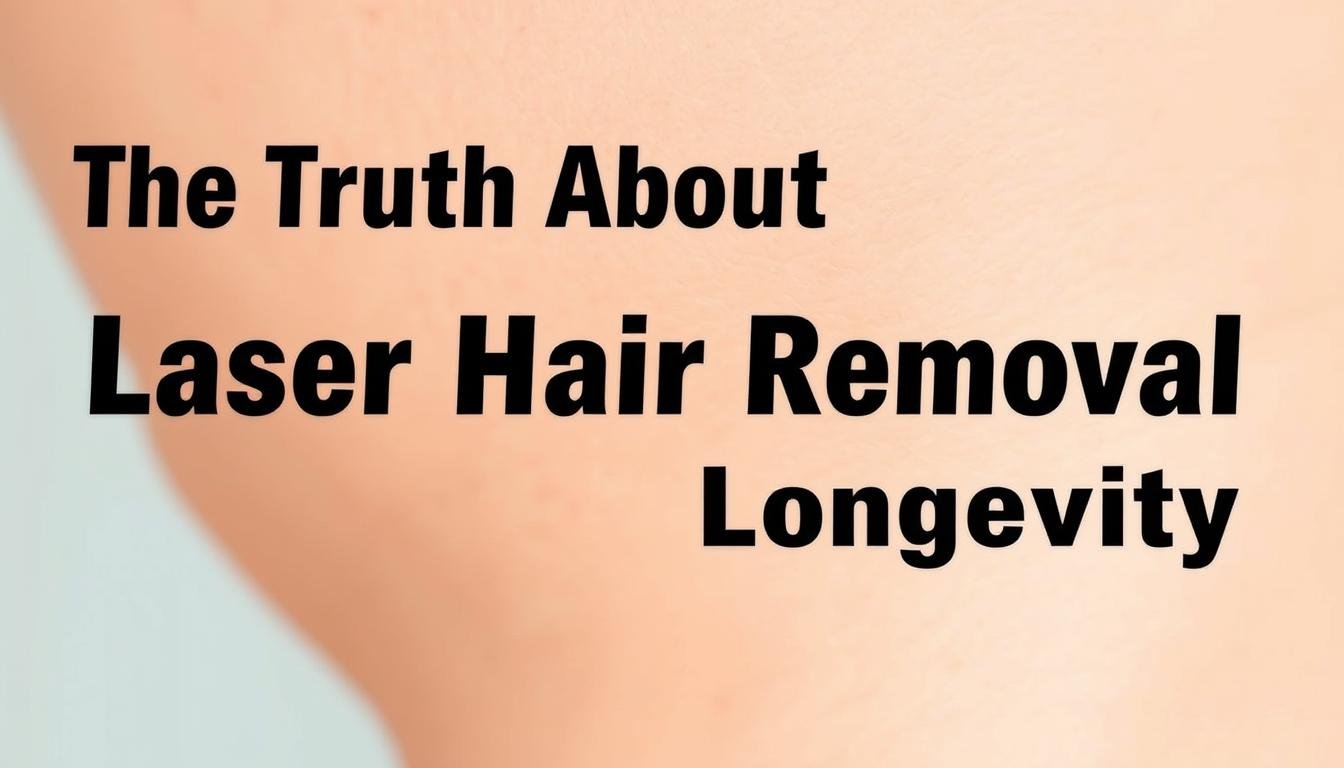Are you tired of shaving every day or getting waxed? Laser hair removal could be the answer. It promises to reduce hair growth for good. At Capri Med Spa, we know you want smooth, easy-to-maintain skin.
Many ask if laser hair removal really works for good. Yes, it can cut hair growth by 80% to 90%. Most people stay hair-free for 6 to 12 months after all treatments. It’s a real, lasting change.
Our Soprano Titanium technology is the latest in hair removal. It’s better than spending over $10,000 on shaving or $23,000 on waxing. Laser hair removal saves you money and time in the long run.
To get permanent results, you’ll need 4 to 8 sessions, spaced 4 to 6 weeks apart. This matches your hair’s growth cycle. While nothing is 100% permanent, our technology at Capri Med Spa is the most effective and comfortable choice today.
Key Takeaways
- Laser hair removal can reduce hair permanently by 80-90% with consistent treatment
- Most clients need 4-8 treatments to achieve optimal long-lasting hair removal results
- Results typically last 6-12 months or longer before maintenance is needed
- Women spend two months of their life shaving and over $10,000 on shaving products
- Soprano Titanium technology at Capri Med Spa offers superior permanent hair reduction
- Annual maintenance sessions help prolong the effects of laser hair removal
- Dark hair responds best to treatment, yielding better permanent reduction results
Understanding How Laser Hair Removal Works
Laser hair removal is a top-notch solution for unwanted hair. It uses light beams to target and remove hair at its source. Let’s dive into the tech behind it and how it works with your body.
The Science Behind Laser Technology
Laser hair removal uses selective photothermolysis. It sends light at specific wavelengths to hit melanin, the hair pigment. This light turns to heat, damaging the follicle but not the skin around it.
- Most patients need 2-6 treatments for the best results
- Best results come when hair and skin contrast well
- After two sessions, hair grows slower and finer
How Lasers Target Hair Follicles
The laser’s energy goes after melanin in the hair shaft. This heat kills the hair and slows down new growth. It works best on dark hair against light skin, as it absorbs more energy.
The Hair Growth Cycle and Treatment Timing
Knowing the hair growth cycle is key for success. Lasers target follicles in the active growth stage.
| Phase | Duration | Characteristics | Treatment Effectiveness |
|---|---|---|---|
| Anagen (Active) | 2-3+ weeks | Darkest pigment, largest root | Highest |
| Catagen (Transitional) | Few days | Follicle shrinking | Limited |
| Telogen (Resting) | 1 week – 1+ year | Dormant follicle | Minimal |
Treatment times vary by area due to growth cycles. Upper lip might need 4-8 weeks, while the back could take 12-16 weeks. This staggered schedule ensures all follicles get treated when they’re active.
Does Laser Hair Removal Never Come Back?
Many people wonder if laser hair removal is forever. The answer is not always yes. Laser treatments greatly reduce hair growth but don’t remove it completely in every case. After 5-6 treatments, most see a big drop in hair that lasts for years.

Studies show that destroyed hair follicles won’t grow back. But, some follicles might just get damaged, leading to regrowth. This new hair is usually thin and less noticeable.
How much hair grows back varies by area. The face, like the chin and neck, sees more regrowth due to hormones. But, areas like the bikini line and underarms keep results longer. Hormonal changes, like during menopause or pregnancy, can also cause new hair to grow.
Laser hair removal is often considered the gold standard for hair reduction, with most patients remaining virtually hair-free for years after completing their recommended treatment plan.
To get the best results, most need 3-7 sessions at first. Then, yearly maintenance keeps regrowth in check. Our Soprano Titanium technology offers better results than older systems, keeping your skin safe and comfortable.
So, does hair grow back after laser treatments? Sometimes, yes. But the new hair is much less and thinner, making laser hair removal a smart choice over shaving or waxing.
Permanent Reduction vs. Permanent Removal: Setting Realistic Expectations
It’s important to know the difference between permanent hair reduction and complete removal before getting laser treatments. The FDA says these treatments are for permanent hair reduction, not removal. This difference is key to understanding what to expect from laser hair removal.
What “Permanent Reduction” Actually Means
Permanent hair reduction means a big drop in terminal hairs after several treatments. Most people see a 70-90% drop in hair growth after 8-12 sessions. This change is big and can be life-changing, but it doesn’t mean all hair will be gone forever.
The success of these treatments depends on hitting hair when it’s growing. Only 20-30% of hair is in this phase at any time. So, having multiple sessions 4-6 weeks apart is needed to catch all hair follicles.
Why Some Hair May Eventually Return
Hair can grow back after laser treatment for a few reasons. Hormonal changes, like during pregnancy or menopause, can wake up dormant follicles. Your genes also affect how well your body responds to laser treatments over time.
Expected Reduction Percentages Over Time
After a full treatment course with advanced tech like Soprano Titanium, most people see:
- 90% less hair right after treatment
- Years of being hair-free for many
- Some spots stay hair-free forever
- Finer, lighter hair if it does grow back
Many people don’t see much hair return even after 10 years. Others might need a session every year or two. The hair that does grow back is usually finer and lighter. For the best results, treatments should hit hair when it’s in its growth phase.
Factors That Influence Laser Hair Removal Longevity
Laser hair removal can greatly reduce hair, but results vary. Many factors affect how long the effects last and if you’ll need more treatments.

Hormonal Changes and Their Impact
Hormonal changes are a big reason for hair regrowth after treatment. Pregnancy, menopause, and conditions like PCOS can cause hormonal hair growth. For women going through menopause, lower estrogen levels can lead to more testosterone. This causes new hair growth, mainly on the face and neck.
Genetic Predispositions
Your genes greatly influence hair growth patterns. If your family has a history of excessive hair growth, you might need more treatments. Studies show genetics affect hair density and regrowth after laser treatments.
Age and Metabolic Factors
As we get older, our metabolism changes. This affects how our bodies react to laser hair removal. Younger people often see longer-lasting results because of more stable hormones. Most people notice treated hairs falling out within two weeks after treatment, showing the laser worked well.
Skin and Hair Color Combinations
The effectiveness of laser hair removal depends on skin and hair types. The best combination is light skin with dark hair, as it offers the best contrast for the laser. Traditional lasers struggle with lighter hair or darker skin tones. But newer technologies, like Nd:YAG lasers, can treat more skin types. This means more people can enjoy the benefits of this procedure.
Why Traditional Laser Technologies Fall Short and How Soprano Titanium Excels
Older laser hair removal systems work for some skin and hair types but not all. They have good results for many but not for darker skin. About 20% of people find these treatments uncomfortable.
The Soprano Titanium laser is a big step up. It uses three wavelengths to target all hair types, no matter the skin tone. It can reduce hair by up to 90% after 6-8 sessions, helping many different people.
Soprano Titanium’s SHR technology makes treatments almost painless. It heats the skin slowly, unlike older systems. This makes it comfortable, with 80% of people feeling little to no pain. Less than 5% have side effects.
| Feature | Traditional Lasers | Soprano Titanium |
|---|---|---|
| Skin Type Range | Limited effectiveness on darker skin | Effective on all skin types |
| Pain Level | Often painful, may require anesthetics | Virtually painless with cooling technology |
| Treatment Speed | Standard | Up to 30% faster |
| Side Effects | Up to 20% of cases | Less than 5% of cases |
The Soprano Titanium laser is also faster. It treats areas up to 30% quicker than old lasers. This means you spend less time in the chair but get great results, perfect for big areas like legs or back.
The Painless Experience: Comfort During Laser Hair Removal
Many people worry about pain when thinking about laser hair removal. Older lasers can be quite painful, scoring a 10 out of 10. But, the Soprano Titanium offers a painless solution without losing effectiveness.
Cooling Technology That Protects Your Skin
Advanced cooling laser technology makes hair removal comfortable. It creates a cool barrier between your skin and the laser’s heat. This keeps your skin at a comfortable temperature while the laser works on hair follicles.
Five cooling systems work together: ice, air, water, contact, and cryogen cooling. This combo eliminates the sharp pain some older lasers cause.
What to Expect During Your Treatment Sessions
A specialist will move the handpiece over your skin during treatment. You might feel a mild warmth, not sharp pain. Treatment times vary, from 5 minutes for small areas to an hour for larger ones.
You’ll need 2-6 sessions, spaced 8-12 weeks apart, for best results. You might see some redness afterward, but it usually goes away in hours. The cooling tech lets you go back to your day right away, with no downtime.
Take acetaminophen an hour before your appointment for more comfort. Drink plenty of water and get enough sleep before your treatment. Avoid caffeine and alcohol to stay less sensitive.
Maintenance Sessions and Body Area Considerations
Different body parts need special care for laser hair removal. After your first treatments, you might need touch-ups once or twice a year. The face, like the chin and upper lip, often needs more sessions because of hormones.
Results vary by body area. Underarms and bikini spots usually do well with laser, lasting long. But arms and legs might need more sessions because they’re bigger and hair grows differently.
What affects how often you need touch-ups? It’s your hair thickness, skin color, and hormonal changes. Laser hair removal usually needs two to six initial sessions, then a maintenance plan tailored to you.
Maintenance visits are less often than your first sessions. You might start with visits every 4-6 weeks, but maintenance could be every 6-12 months. Many find this easier than shaving or waxing all the time.
For the best results, treatments should happen when hair follicles are growing. This is why you need multiple sessions. Even with maintenance, laser hair removal offers big benefits like less ingrown hairs and skin problems. Choosing a trusted clinic means you get advice right for your body and needs.
The Capri Med Spa Difference: Expertise, Technology, and Value
At Capri Med Spa, we’re all about top-notch laser hair removal services. Our team is highly trained to make sure you get a safe, comfy, and effective treatment. We use the latest Soprano Titanium tech for less pain and better results, unlike old laser methods.
When you come in for a personalized chat, our pros will look at your hair and skin. They’ll create a treatment plan just for you. This way, we get the laser settings right for the best results and less chance of side effects.
Laser hair removal is a smart choice for saving time and money over time. It’s also a more lasting fix than shaving or waxing. At Capri Med Spa, you’ll get results that last, letting you live without the worry of unwanted hair.
FAQ
Is laser hair removal truly permanent?
Laser hair removal often leads to long-lasting hair reduction, not complete removal for everyone. Studies show that some hair follicles won’t regrow. But, others might grow back over time, usually with finer, lighter hair.
What is the difference between “permanent reduction” and “permanent removal”?
The FDA calls it “permanent hair reduction,” not “permanent hair removal.” This means you can see a 70-90% decrease in hair after a full treatment. Some hair might grow back, needing occasional touch-ups.
What factors affect how long laser hair removal results last?
Hormonal changes, genetics, age, and skin/hair color can affect how long results last. New technologies like Soprano Titanium aim to overcome these issues for better results.
How does Soprano Titanium laser technology compare to traditional laser hair removal?
Soprano Titanium uses a new triple wavelength technology and SHR method. It tackles the pain, limited effectiveness, and side effects of old lasers for better results.
Is laser hair removal painful?
Old lasers can be very painful. But, Soprano Titanium’s cooling tech makes it comfortable. It targets hair follicles without hurting the skin’s surface.
How often do I need maintenance sessions for my laser hair removal results?
Some people are happy with their results for years without needing touch-ups. Others might need occasional sessions. How often depends on your body and the treated areas.
What makes Capri Med Spa stand out for laser hair removal?
Capri Med Spa has expert technicians and advanced Soprano Titanium tech. They offer personalized plans and focus on the best results. This ensures clients get lasting freedom from unwanted hair.


